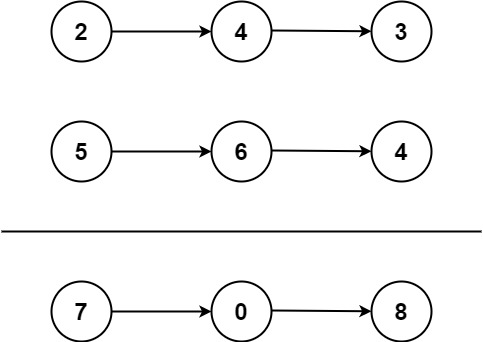LeetCode in Racket
2. Add Two Numbers
Medium
You are given two non-empty linked lists representing two non-negative integers. The digits are stored in reverse order, and each of their nodes contains a single digit. Add the two numbers and return the sum as a linked list.
You may assume the two numbers do not contain any leading zero, except the number 0 itself.
Example 1:

Input: l1 = [2,4,3], l2 = [5,6,4]
Output: [7,0,8]
Explanation: 342 + 465 = 807.
Example 2:
Input: l1 = [0], l2 = [0]
Output: [0]
Example 3:
Input: l1 = [9,9,9,9,9,9,9], l2 = [9,9,9,9]
Output: [8,9,9,9,0,0,0,1]
Constraints:
- The number of nodes in each linked list is in the range
[1, 100]. 0 <= Node.val <= 9- It is guaranteed that the list represents a number that does not have leading zeros.
Solution
; Definition for singly-linked list:
#|
; val : integer?
; next : (or/c list-node? #f)
(struct list-node
(val next) #:mutable #:transparent)
; constructor
(define (make-list-node [val 0])
(list-node val #f))
|#
(define/contract (add-two-numbers l1 l2)
(-> (or/c list-node? #f) (or/c list-node? #f) (or/c list-node? #f))
(add-two-numbers-help l1 l2 0)
)
(define (add-two-numbers-help l1 l2 carry-sum)
(cond
[(and (false? l1) (false? l2)) (if (zero? carry-sum) #f (list-node carry-sum #f))]
[(false? l1) (list-node (modulo (+ (list-node-val l2) carry-sum) 10) (add-two-numbers-help l1 (list-node-next l2) (/ (- (+ (list-node-val l2) carry-sum) (modulo (+ (list-node-val l2) carry-sum) 10)) 10)))]
[(false? l2) (list-node (modulo (+ (list-node-val l1) carry-sum) 10) (add-two-numbers-help (list-node-next l1) l2 (/ (- (+ (list-node-val l1) carry-sum) (modulo (+ (list-node-val l1) carry-sum) 10)) 10)))]
[else (list-node (modulo (+ (list-node-val l1) (list-node-val l2) carry-sum) 10) (add-two-numbers-help (list-node-next l1) (list-node-next l2) (/ (- (+ (list-node-val l1) (list-node-val l2) carry-sum) (modulo (+ (list-node-val l1) (list-node-val l2) carry-sum) 10)) 10)))]
)
)

